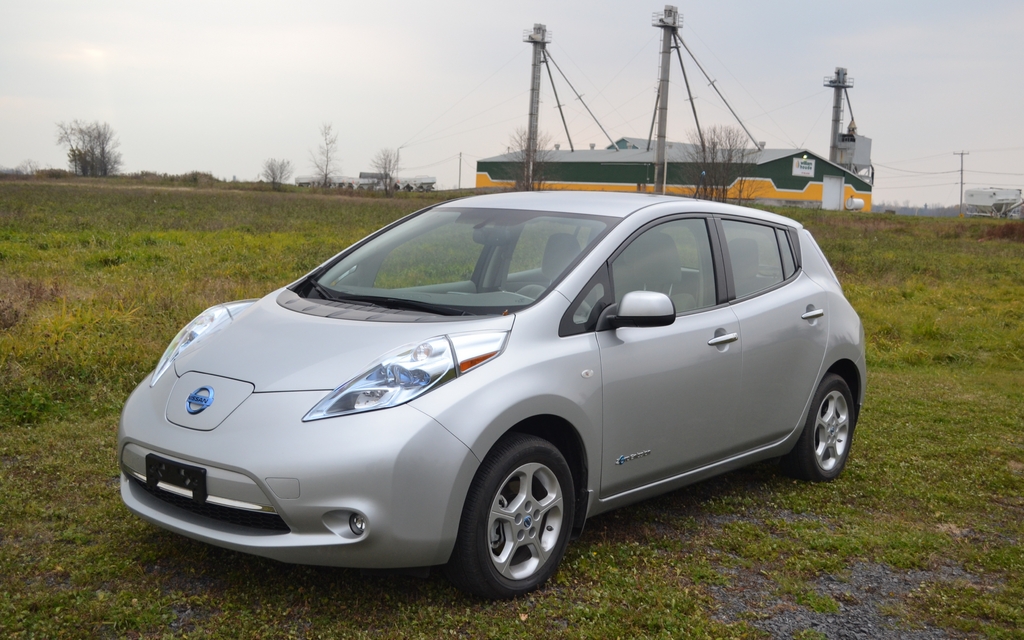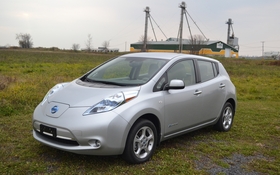Gas-free Driving: Life with the LEAF

| Strong points |
|
|---|---|
| Weak points |
|
Electric cars are now part of our everyday lives. As proof, Nissan recently delivered its first LEAFs. The idea of going to and from work every day for a week without racking up gas charges on my credit card was enough to make my mouth water. After a week of “scientific testing” with this car, however, I have to admit that it forced me to make more compromises than expected.
Not particularly distinctive
When I went to pick up my test model, I was struck by the fact that the car’s exterior is not particularly futuristic, unlike many other hybrid cars. In fact, throughout the trial, very few people realized I was driving an all-electric vehicle. Similarly, the LEAF’s interior is much like other regular compact cars, offering space for five passengers and featuring a rear hatch for easy access to ample cargo space. Most of the controls are also similar to those on a normal car. Just the instrumentation and gearshifter have a more distinct, modern design.
- Also: No gas? No problem, with a new electric car rental program in Orlando
- Also: Nissan Leafs Recalled
The start of the test drive
As soon as I pushed on the contact button, a yellow gauge indicated that the car had an approximate range of 138 km – which is less than the 160 km they promised. I told myself that this was, nonetheless, more than enough to get me to work. The LEAF keeps the driver up-to-speed (so to speak) by displaying information on its touch screen. This includes information on energy consumption and even a map connected to the navigation system that shows how far you can go without having to recharge. It also indicates the nearest charging stations, including any that you might have added yourself. I’ve got to admit that Nissan made a big effort to include features designed to reduce any stress resulting from getting used to an all-electric vehicle.
Since it was early fall and the temperature was just starting to drop, I switched on the automatic climate control. Suddenly, the vehicle’s range dropped by 16 km. A reduction in range seemed like a reasonable compromise for keeping the interior warm and cozy – but the amount it dropped surprised me. Once I set the gearshift to D, I was taken aback by the fact that I was driving, but there was absolutely no engine sound. The only thing you could hear is the Approaching Vehicle Sound for Pedestrians (VSP) which is audible at 30 km/hr and under.
On the road, the LEAF was totally transparent. Push the accelerator, and it accelerates well. It has no trouble keeping up with traffic and, with a maximum speed of 140 km/hr, you can even earn yourself a speeding ticket in this car. To save on fuel, shift into Eco mode. This maximizes fuel efficiency and battery recharge when you brake. However, you can forget punchy accelerations in this mode, as even forceful pressure on the accelerator is met with slower accelerations. It’s as if it were saying to you, “If you want to drive efficiently, cool it!”
Once I got to work, I quickly scanned the parking lot for an electric outlet. Ah-ha! Found one! And with no other vehicle parked in front of it! Throughout the afternoon, I monitored its charge status via an iPhone app. And when I left for the day, I even turned on the climate control with my phone!
A big surprise
With about 70 km in range, I thought I had plenty to get me home (which is 55 km away on the highway). Surprise! As I approached my house, however, there were just 10 km left on the battery. So many people had told me that the range really lasted till the very end. This really bothered me. So I decided to put it to the test by doing away with comfort. I turned off the heat and gained an extra 6 km of range, which translated into additional peace of mind on the way home.
When I plugged the vehicle in, I was shocked to see that the charge time was 19 hours. A quick calculation and I realized it wouldn’t have enough charge to get me to work the next day. So I checked my facts and indeed, that’s the amount of time it takes at a 120-volt outlet. If I had had a 240-volt outlet, I could have recharged it in just 7 hours. But naturally my house does not have a 240-volt outlet. If you’re thinking of buying one of these cars, make sure you have a domestic charging station.
The next morning, the car claimed to have 140 km of range. But after driving the 66 km to work, choosing another itinerary, there were just 51 km left. Somehow, those 66 clicks had eaten up 89 km in range. It seems that weather conditions and driving style can really come into play. The amount of range displayed is just an estimate and can vary significantly depending on different factors. At lunch hour, I went for a quick bite with my coworkers and thus amputated another couple of kilometres from the car’s potential. By early afternoon, its range was down to 30 km. Panic! With just four hours to go before quitting time, I didn’t see how I could get the range up to approximately 90 km to get me home.
Mission impossible
I had no choice but to delay my departure – which led my boss to believe that I was an overzealous worker. By the time I called it a day, the car had just over 60 km of range. I really wasn’t convinced it would make it. So, I turned off all functions that might suck the juice out of the car. I also opted to take secondary roads for a shorter but slower route home. Another thing I did was adapt my driving style by minimizing the amount of time spent at each stop, accelerate as though I was walking on eggshells, and keeping my speed between 50-60 km/hr (this seems to be the most efficient speed), much to the frustration of the cars behind me. With all this, I not only made it home, but I managed to clock one real kilometre for every kilometre of range. This proved to me that the LEAF does a lot better on secondary roads and at lower speeds. Highways and highway speed limits really use up a lot more power.
In sum, after covering more than 800 km in one week, I concluded that I was not part of the LEAF’s target market. I just drive too far every day and the highways I normally take don’t bring out the best in this urban vehicle. Opting for an all-electric car means managing your trips, which can contribute to your stress levels. Compared to conventional cars, the LEAF definitely involves making compromises. That said, every time you drive past a gas station, you’re reminded of what the LEAF represents.
My conclusions after my week-long test drive of the Nissan LEAF
- Charging at a regular outlet is for emergencies only. Otherwise, you really need a 240-volt domestic charging station.
- Given our extreme Canadian weather, having a heated garage would really improve the car’s charge time and range.
- Depending on your driving style and route, the number of kilometres stated in the car’s range will decrease faster than the number of kilometres you’ve actually driven. Choose slower city roads for improved range.
- Forget sporty driving. You’ll really need to adopt green driving techniques to save power. In some cases, you may also have to give up your creature comforts, too.
- After five years of normal use, the battery capacity (and thus the vehicle’s range) is reduced by 20%. With an eight-year guarantee, we hope that Nissan will offer battery replacement options at reduced prices.
- Frequent charging, energetic driving and extreme weather can hinder the useful life of the battery.











